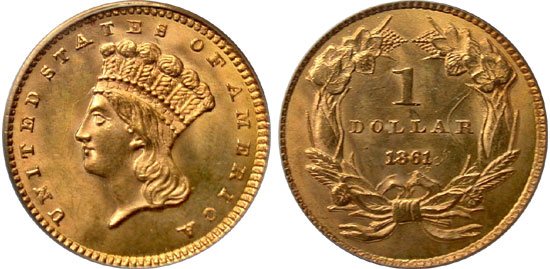Guide to U.S Indian Princess Gold Dollars
The Indian Princess Gold Dollar was struck from 1854 to 1889 and represented the second series for the denomination. In 1856 the obverse design was modified, creating two distinct subtypes. The first carries a smaller portrait and higher relief, while the second carries a larger portrait and lower relief. The coins were struck at five different mint facilities including Philadelphia, Dahlonega, Charlotte, New Orleans, and San Francisco, although production would take place almost exclusively at the Philadelphia Mint after the start of the American Civil War. The series includes a number of issues with extremely low mintages that have come to be recognized as great rarities.

The gold dollar denomination had been authorized under the Coinage Act of March 3, 1849, as a direct result of the California Gold Rush. The initial series was struck for five years and in relatively large numbers, but there were concerns that the coins were too small to be conveniently used in commerce. One potential solution was to place a hole in the middle of the coins in order to increase the diameter while staying within the limits of the gold content. This idea had also been suggested in the late 1840s, but at the time it was not considered practical since producing the planchets with holes involved a cumbersome and costly process.
In 1854, an alternate solution was found simply by reducing the thickness of the coins in order to allow an increase in diameter from 13 to 15 millimeters. Along with change in diameter, new obverse and reverse designs were created by United States Mint Chief Engraver James Barton Longacre. The obverse design features an Indian or Native American princess wearing an ornate feathered crown with a band inscribed LIBERTY. The additional inscription UNITED STATES OF AMERICA appears widely spaced surrounding the portrait. The reverse design features an agricultural wreath, composed of corn, cotton, tobacco, and wheat. The denomination 1 DOLLAR and the date appears within the wreath.
During the initial years of the series, the Philadelphia Mint struck the Indian Princess Gold Dollars in reasonably high numbers and the coins appeared in circulation with some frequency. Mintage levels at the Charlotte and Dahlonega Mints were significantly lower, leading to the creation of numerous scarce issues. The landscape would change following the start of the Civil War, which caused widespread hoarding of all gold, silver, and eventually copper coins. Production at three of the four branch mints was discontinued, and the output at the Philadelphia Mint plummeted to the low thousands.
Production reached its absolute low in 1875 with a mintage of merely 400 pieces. By this point, it had become apparent that the gold dollar denomination was not really necessary or popular within circulation. Mint Directors began to advocate for the discontinuation of the denomination, which was used mostly for gift giving or within jewelry. In 1889, the final coins of the series and denomination were struck for circulation and in proof format. Under the Act of September 26, 1890, Congress abolished the gold dollar, along with the three cent nickel and three dollar gold piece.
The Philadelphia Mint struck proof versions of the Indian Princess Gold Dollar for each year of the series. The earliest proof issues from the 1850’s are extremely scarce and typically fewer than 10 examples are known to exist for each date. Throughout the 1860’s and 1870’s mintage levels remained minimal and most dates are represented by 20 or fewer surviving specimens. Proof mintages would rise above 1,000 for the final issues of the series from 1884 to 1889. These issues survive in high numbers and represent some of the most readily available classic proof gold coins issued by the United States Mint.

